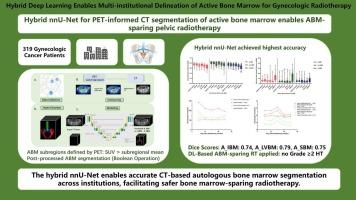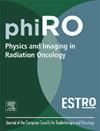混合深度学习使多机构的活跃骨髓描绘妇科放疗
IF 3.3
Q2 ONCOLOGY
引用次数: 0
摘要
背景与目的妇科肿瘤盆腔放射治疗不可避免地会照射到敏感部位,如髂骨、腰椎和骶骨。以18F-FDG PET/CT为参照,我们开发了一种深度学习方法在妇科肿瘤患者CT上检测造血活性骨髓(ABM)并评估临床疗效。材料和方法回顾性分析来自5家医院的319例患者。ABM被分为三个18F-FDG PET/ ct定义的亚区:活跃的髂骨髓(A_IBM)、活跃的骶骨骨髓(A_SBM)和活跃的腰椎骨髓(A_LVBM),定义为标准化摄取值超过分区域平均值的区域。训练了6个深度学习模型:混合nnU-Net、U-Net、V-Net、ResU-Net、nnU-Net和UNETR。混合nnU-Net方法通过布尔运算将nnU-Net预测与解剖骨结构相结合,提供了一种后处理策略。数据集被分成290个案例用于训练,29个案例用于独立测试。使用Dice相似系数(dsc)和第95百分位Hausdorff距离(HD95)评估性能。对2例临床病例进行血液学监测下保留abm放射治疗的前瞻性评价。结果混合nnU-Net对A_IBM(0.74±0.06)、A_LVBM(0.79±0.07)和A_SBM(0.75±0.06)的dsc最高,与大多数模型相比有显著提高(p <;0.001), nnU-Net除外。尽管ResU-Net在两个子区域的HD95较低,但混合nnU-Net显示出更高的准确性。前瞻性病例未发生≥2级血液学毒性。结论:这项多机构研究证实,混合nnU-Net可以准确地从CT图像中分割ABM,显示出保留ABM放疗的潜力。本文章由计算机程序翻译,如有差异,请以英文原文为准。

Hybrid deep learning enables multi-institutional delineation of active bone marrow for gynecologic radiotherapy
Background and purpose
Pelvic radiotherapy for gynecologic cancer inevitably irradiates sensitive areas like iliac bones, lumbar vertebrae, and sacrum. Using 18F-FDG PET/CT as a reference, we developed a deep learning method to detect hematopoietic active bone marrow (ABM) on CT in gynecologic cancer patients and assess clinical benefits.
Materials and methods
We analyzed 319 patients from five institutions retrospectively. ABM was divided into three 18F-FDG PET/CT-defined subregions: active iliac bone marrow (A_IBM), active sacral bone marrow (A_SBM), and active lumbar vertebrae bone marrow (A_LVBM), defined as areas with standardized uptake values exceeding subregional means. Six deep learning models were trained: hybrid nnU-Net, U-Net, V-Net, ResU-Net, nnU-Net, and UNETR. The hybrid nnU-Net approach integrated nnU-Net predictions with anatomical bone structures via Boolean operations, providing a post-processing strategy. The dataset was split into 290 cases for training and 29 for independent testing. Performance was evaluated using Dice similarity coefficients (DSCs) and 95th percentile Hausdorff distance (HD95). Two clinical cases were prospectively evaluated for ABM-sparing radiotherapy with hematologic monitoring.
Results
The hybrid nnU-Net achieved the highest DSCs for A_IBM (0.74 ± 0.06), A_LVBM (0.79 ± 0.07), and A_SBM (0.75 ± 0.06), with significant improvements over most models (p < 0.001), except nnU-Net. Despite ResU-Net’s lower HD95 in two subregions, hybrid nnU-Net showed superior accuracy. No grade ≥2 hematologic toxicity occurred in prospective cases.
Conclusion
This multi-institutional study confirms that the hybrid nnU-Net accurately segments ABM from CT images, showing potential for ABM-sparing radiotherapy.
求助全文
通过发布文献求助,成功后即可免费获取论文全文。
去求助
来源期刊

Physics and Imaging in Radiation Oncology
Physics and Astronomy-Radiation
CiteScore
5.30
自引率
18.90%
发文量
93
审稿时长
6 weeks
 求助内容:
求助内容: 应助结果提醒方式:
应助结果提醒方式:


